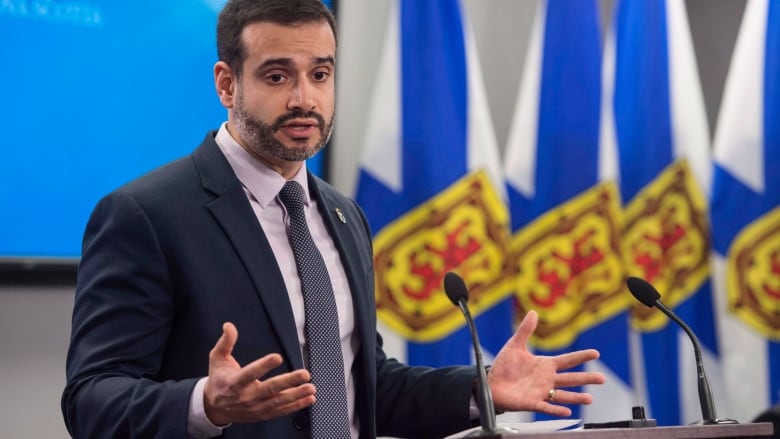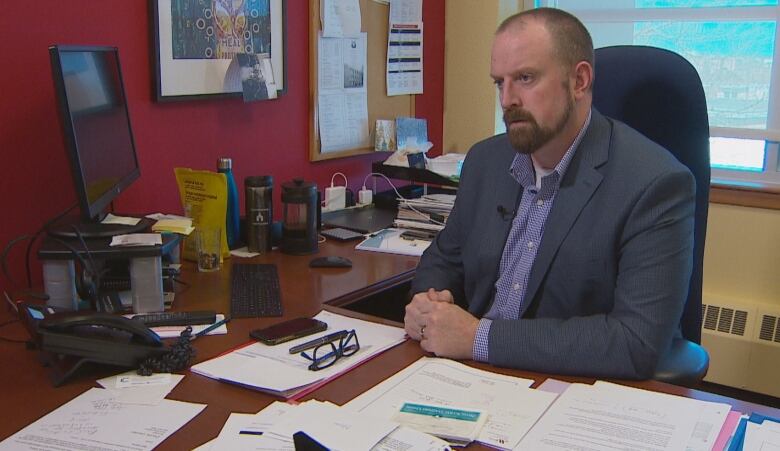All Nova Scotia students to return to school in September
Province also outlines contingency plans for blended and at-home learning

All Nova Scotia students and teachers will return to the classroom on Sept. 8, with contingency plans in place should there be a new flareup of COVID-19.
Education Minister Zach Churchill released his government's back-to-school plan on Wednesday.
It will begin with a 100 per cent return to learning as usual, including for pre-primary, with increased health and safety protocols, enhanced cleaning of schools and buses and more spacing between students.
"Health experts the IWK Health Centre, Public Health psychologists and health professionals all agree that the best place for children is in the classroom," Churchill said during a briefing.
"The safety of our staff and students is central to our planning. As they return, there will be enhanced health and safety measures in our schools for our students and our staff."
Only students and staff will be allowed in schools. Handwashing and self-screening will be required as people enter buildings and before and after lunch, and anyone who feels ill will be isolated, masked and sent home.
There will be no sharing of supplies or food, and teachers are being encouraged to move classes outside if possible. Music and gym classes will take place, but with modifications to allow for public health requirements. Students will eat lunch at their desks and cafeteria services will be delivered to them.
All students and drivers will be required to wear masks when travelling on buses, and masks will be required in the hallways and other common areas of high schools.
Education Department officials say masks will be provided for students who do not have one, and that accommodations will be made for any students who are immunocompromised and not able to attend school.
The government said all learning supports will be in place as usual, with additional targeted support for Black and First Nations students. The province is spending $15 million and postings are out now to hire additional support staff to meet student needs.
Dr. Robert Strang, the province's chief medical officer of health, said the plan reflects the balance his office and the government need to confront COVID-19.
"On the one hand, as we reopen our economy, our society, our community and schools, we do increase the risk of transmission of COVID-19. But on the other hand, keeping everything tightly closed down also has substantive risks and is not something we can do for the long term."
Strang said parents and students alike are better off when school can function normally, and he said the province's epidemiology supports the 100 per cent return plan.
The government also released details about what will happen should blended learning be required, or a return to full learning from home. While Strang could not provide hard targets for what would lead to the change within a given school or group of schools, ultimately that decision falls to him.
Strang said he expects there will be cases of COVID-19 in schools and, if there are, they will be investigated the way any other case is and the school community would be made aware, just as they are with other illnesses in schools.
In the case of blended learning, students in grades primary to 8 would continue attending school, with smaller class sizes and students in bubbles as much as possible with their classmates and teacher.
To make that work, some students could be moved into middle schools or high schools. Education Department officials say all regional centres of education have mapped out space to accommodate additional distancing requirements, and that space exists.
In that scenario, students in grades 9-12 would do most learning from home and any hands-on learning would happen in schools on a modified schedule. Students on individualized program plansmay attend school depending on their needs and all staff would work from schools.
New technology
To help address shortcomings identified in learning from home this past spring, the province has spent $4 million on 14,000 computers to be made available to any students without consistent access to devices. Students without access to high-speed internet would receive assignments either via the telephone or a USB thumb drive.
Even if learning moves to a blended model, student support services will remain in schools. In the case of all home learning, services will be available online or at a student's home, in some cases.
Churchill said these steps are in response to information his departmentgathered from thousands of surveys of parents and students following at-home-learning this past springwhen COVID-19 forced the shutdown of schools across the province for the duration of the school year.
While schools operate as usual, clubs will resume with some modifications and some, but not all, sports will return. Schools will share schedules and plans with families in the fall when classes resume. Assemblies and parent-teacher and curriculum nights will be held remotely.
During online learning, there would be clear expectations for teachers and students related to learning, and teachers will deliver a mix of self-directed learning and real-time instruction.
Report cards to be issued
Grades, marks and report cards will be issued as usual. Provincial Grade 10 exams will take place in math, French and English.
Dr. Andrew Lynk, the chief of pediatrics at the IWK Health Centre and chair of a pediatrics group that advised public health on the plan, said heand his colleagues agree with the government's approach, particularly because of the support schools provide to some children.
"Kids who are living in poverty, who are affected by racism and discrimination, family violence or have disabilities or have special needs," he told reporters during a telephone briefing.
Lynk also pointed to other supports, such as mental health, lunch and breakfast programs, access to vaccinations and pre-primary, which helps close gaps for some children.
Reaction to the plan
Erica Baker, a mother of three boys who range in age from 9 to 16 and the founder of a group that called on the province to produce a plan, said she's pleased her sons will return to school in September.
Baker said she thinks the province hasdone a good job and listened carefully to medical experts and parents in putting together the plan.
"I think they have been thoughtful and I love that they are putting some flexibility into the plan, as well," she said.
But while she's satisfied with the approach that will be used in September, Baker said she thinks there needs to be more details about how blended learning or full home learning would take place, particularly as it relates to virtual teachingand curriculum availability.

Nova Scotia Teachers Union president Paul Wozneycalled the plan a good starting point and praised the government for making sure people who need personal protective equipment will get it.
But Wozney said he hasconcerns about how difficult it will be to keep high school students from intermingling, even within classes, and said more work is required to address that concern.
He said he'd like to see a similar approach to what's being done in Newfoundland and Labrador, where there are clear targets for what would lead to the scaling back of in-school learning.
"Parents need to know when we're going to scale up restrictions or when we're going to relax. So that's a missing ingredient that we will continue to push to see included."
Opposition wants details
Opposition parties also called for more details.
In a news release, PC education critic Tim Halman, a former teacher, called for a commitment from Churchill that he will provide regular and detailed updates in the coming weeks leading up to the opening of schools to help address any outstanding questions.
NDP Leader Gary Burrill said the plan lacks detail about what would happen should schools have to revert to at-home learning or a blended model.
"We know COVID-19 requires us to be flexible, but the government must also be thoughtful and ensure that plans consider all aspects," he said in a news release. "Today's plan does not address what supports will be available for working parents to manage another full-time at-home learning period successfully."
If theplan isto work, Baker said it will also be important for the province to remain vigilant about who is coming into Nova Scotia, and for members of the general public to be mindful about where they are going and how they interact with people.












_(720p).jpg)


 OFFICIAL HD MUSIC VIDEO.jpg)
.jpg)



























































































